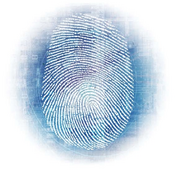Definitions[]
Biometrics[]

A fingerprint is
| “ | a deposit of fatty residue left behind after a finger touches a surface and the sweat evaporates. The pattern left behind is unique to an individual and can be used to identify and link evidence in a similar way to DNA.[1] | ” |
Fingerprints are formed from the skin's uneven surface of ridges and valleys. When recorded, a fingerprint appears as a series of dark lines that represents the high, peaking portion of the ridged skin; the white space is the valley (the low, shallow portion of the ridged skin) between the ridges. Ridges do not always form long and continuous patters. Often, ridges are shorter and stop and start abruptly. The result is a unique pattern of specific characteristics such as ending ridges or dividing ridges and dots.
The flow of the overall ridges is used to assign a fingerprint classification (loops, whorls, etc.). Minutiae information — the location, direction and orientation of the ridge endings and bifurcations (splits) along a ridge path — are then gathered and used to develop the fingerprint template.[2]
Technology[]
A fingerprint is
| “ | a small mark physically placed on the magnetic surface of each . . . diskette which contains certain information that cannot be altered or erased.[3] | ” |
| “ | [a] set of information elements that identifies a device or application instance.[4] | ” |
Overview (Biometrics)[]
"Fingerprints are a common biometric used in modern mobile devices over the past several years. Multiple types of fingerprint sensors exist, such as optical, capacitive, and ultrasonic, each with unique ways of assessing characteristics of a biometric sample. In general, fingerprint scanners on mobile devices have a smaller surface area than traditional scanners, affecting resolution, which may impact accuracy."[5]
References[]
- ↑ Interpol Handbook on DNA Data Exchange and Practice, Glossary, at 105.
- ↑ Privacy and Biometrics: Building a Conceptual Foundation, at 13-14.
- ↑ Vault Corp. v. Quaid Software Ltd., 847 F.2d 255, 256, 7 U.S.P.Q.2d (BNA) 1281 (5th Cir. 1988)(full-text).
- ↑ Privacy Considerations for Internet Protocols, at 8.
- ↑ NISTIR 8080, at 17.
See also[]
- Acoustic fingerprinting
- Arch
- Automated Fingerprint Identification System (AFIS)
- Bifurcation
- Biometric authentication
- Browser fingerprints
- Core point
- Delta point
- Device fingerprint
- Digital fingerprint
- Exemplar
- Finger scan
- Fingerprint filter
- Fingerprint identification
- Fingerprint Identification Records System
- Fingerprint recognition
- Fingerprint Technology Vendor Evaluation
- Fingerprinting
- Flat fingerprint
- Friction ridge
- Integrated Automated Fingerprint Identification System (IAFIS)
- Latent fingerprint
- Live capture
- Loop
- Minutia(e)
- Minutia(e) point
- National Fingerprint File
- Operating system fingerprinting
- Packet fingerprinting
- Ridge ending
- Rolled fingerprint
- Slap fingerprint
- The FBI Fingerprint Identification Automation Program: Issues and Options
- Thumbprint
- Valley
- Whorl
| This page uses Creative Commons Licensed content from Wikipedia (view authors). | 
|